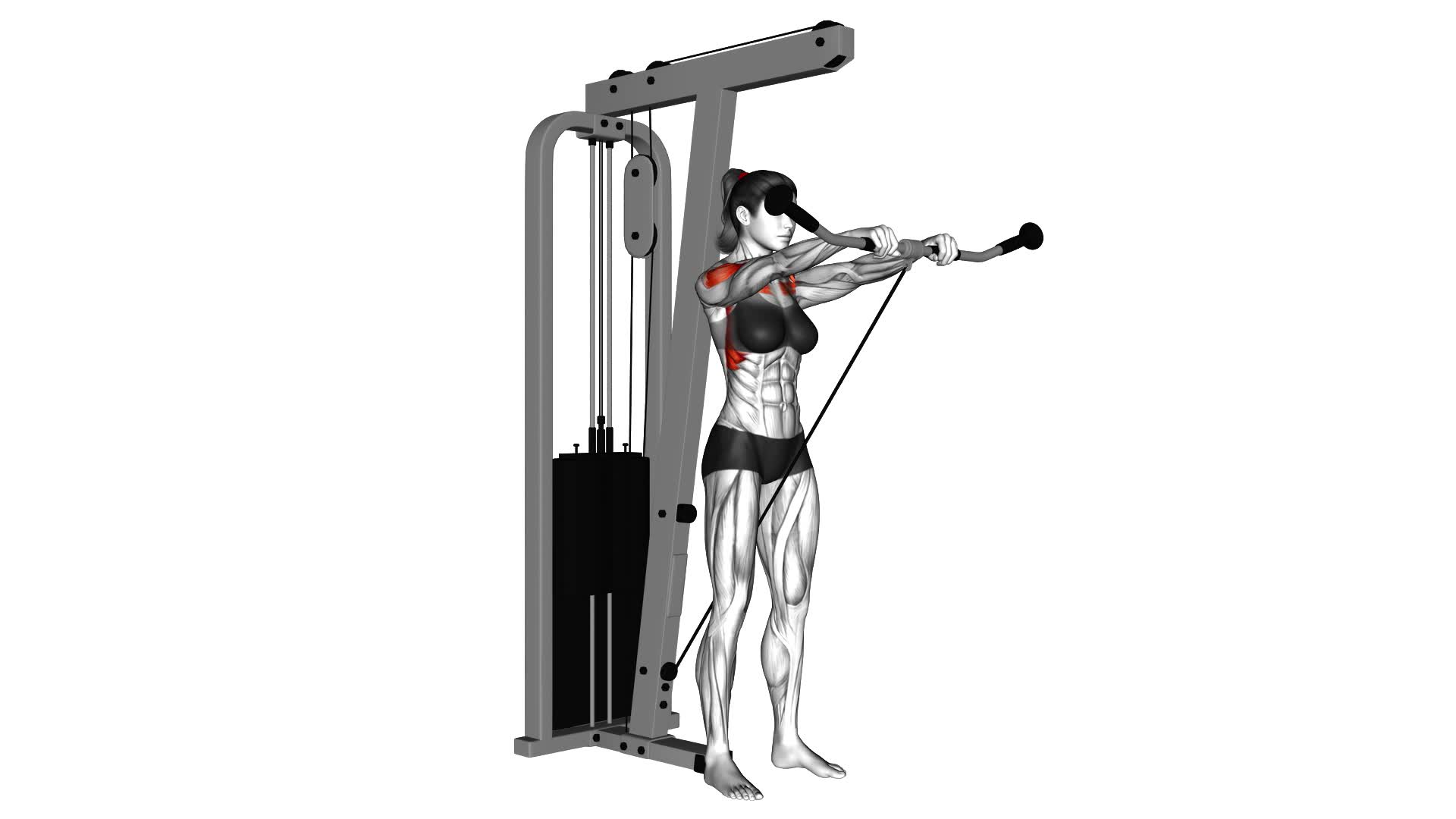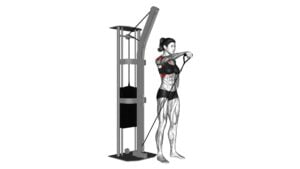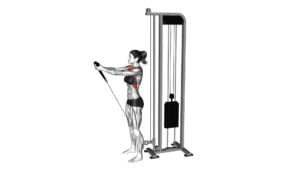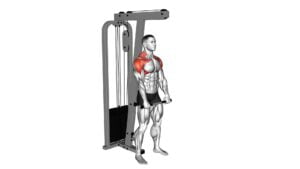Cable Front Raise (female) – Video Exercise Guide & Tips

Ready to strengthen and tone your shoulders? Look no further than the cable front raise. In this video exercise guide, we'll show you the proper form and technique for this effective move.
Watch This Exercise Video
Say goodbye to common mistakes and hello to variations and progressions that will challenge you. With these tips, you'll maximize your shoulder gains and achieve the results you've been seeking.
Let's get started!
Key Takeaways
- Cable front raise engages multiple muscle groups, including the front deltoids, shoulders, upper back, and arms.
- This exercise improves overall upper body strength, stability, posture, and shoulder mobility.
- It helps prevent muscle imbalances and ensures overall shoulder strength and stability.
- Cable front raise can be modified and varied to target different areas of shoulder muscles and accommodate specific needs or limitations.
Benefits of the Cable Front Raise
To maximize the effectiveness of your cable front raise, focus on the benefits that come from engaging multiple muscle groups. This exercise primarily targets the front deltoids, but it also works the muscles in your shoulders, upper back, and arms. By involving multiple muscle groups, the cable front raise helps to increase overall upper body strength and stability. Additionally, this exercise can improve your posture and shoulder mobility.
One of the key benefits of the cable front raise is that it allows for variations in hand position and grip. By altering your grip, you can emphasize different muscles within the shoulders. For example, using an overhand grip with your palms facing down will target the front deltoids more, while using an underhand grip with your palms facing up will engage the rear deltoids. Experimenting with different grip variations can help you achieve a more well-rounded shoulder workout.
Proper Form and Technique
For proper form and technique during the cable front raise, position yourself in front of the cable machine with your feet shoulder-width apart. Stand tall, engage your core, and maintain a slight bend in your knees. Hold the handles of the cable machine with an overhand grip, placing your hands slightly wider than shoulder-width apart. This will ensure a firm grip and stability throughout the exercise.
To perform the cable front raise, exhale and lift the handles straight in front of you, keeping your arms extended and parallel to the floor. Avoid using momentum or swinging your body to lift the weight. Instead, focus on using your shoulder muscles to control the movement. Inhale and slowly lower the handles back down to the starting position, maintaining control throughout.
Common errors to avoid during the cable front raise include shrugging your shoulders, hunching your back, and using excessive weight. These mistakes can put unnecessary strain on your neck, back, and shoulders, increasing the risk of injury. It's important to start with a lighter weight and gradually increase as your strength improves.
Exercise modifications for the cable front raise include using a lower cable attachment, using dumbbells instead of a cable machine, or performing the exercise seated. These modifications can help target different muscle groups and accommodate individuals with specific needs or limitations.
Equipment and Setup
To properly set up for the cable front raise exercise, you'll need a cable machine and ensure it's adjusted to the appropriate height for your height and range of motion. The cable machine should have a handle attachment that allows for a comfortable grip. Make sure the cable is securely attached to the machine and that the weight stack is set to a challenging yet manageable resistance.
If you don't have access to a cable machine, there are alternative exercises that can target the same muscles. Dumbbell front raises and resistance band front raises are excellent alternatives to the cable front raise. These exercises can be performed with a set of dumbbells or resistance bands, making them accessible options for home workouts or when you don't have access to a cable machine.
When it comes to the best cable front raise equipment, it's essential to choose a cable machine that's sturdy and well-maintained. Look for machines with smooth pulleys and cables that move freely. Adjustable height options are also beneficial, as they allow you to customize the machine to your specific needs.
Common Mistakes to Avoid
When performing cable front raises, it's important to avoid common mistakes that can hinder your progress.
First, make sure your hand positioning is correct by gripping the cable handles with an overhand grip and keeping your wrists straight.
Avoid rounding your shoulders during the exercise, as this can lead to poor form and potential injury.
Lastly, be mindful of using too much weight, as this can compromise your technique and prevent you from fully engaging the targeted muscles.
Incorrect Hand Positioning
Avoid gripping the cable handle too tightly during the cable front raise exercise. One of the common hand mistakes to avoid is squeezing the handle too hard, which can lead to wrist strain. Instead, aim for a firm but relaxed grip on the handle.
This will allow you to maintain control of the cable while minimizing unnecessary tension in the wrists. By keeping your grip relaxed, you can focus on engaging the muscles in your arms and shoulders without putting excessive strain on your wrists.
Rounding the Shoulders
If you round your shoulders during the cable front raise exercise, you risk compromising proper form and reducing the effectiveness of the workout. Rounding the shoulders can lead to shoulder impingement, a condition where the tendons in the shoulder become compressed. To prevent this, focus on maintaining proper shoulder mobility and alignment throughout the exercise.
Here are some common mistakes to avoid:
- Shrugging your shoulders: Keep your shoulders relaxed and down, away from your ears.
- Arching your back: Engage your core and keep your spine in a neutral position.
- Overextending your arms: Avoid locking your elbows and keep a slight bend in your arms to prevent strain on the joints.
Using Too Much Weight
To prevent injury and maximize the effectiveness of the cable front raise exercise, it's important to be mindful of using an appropriate amount of weight. Using too much weight can increase the risk of overtraining and lead to potential injuries. Overloading the muscles beyond their capacity can strain the shoulders, causing pain and discomfort.
It's crucial to listen to your body and start with a weight that allows you to perform the exercise with proper form and technique. Gradually increase the weight as your strength and stability improve. Remember, the goal is to challenge your muscles without compromising your safety. By using the right amount of weight, you can reduce the risk of overtraining and ensure injury prevention.
Now let's move on to discussing variations and progressions to further enhance your cable front raise workout.
Variations and Progressions
Start with 3-5 pound dumbbells and gradually increase the weight as you get stronger. This will ensure that you're challenging your muscles without risking injury.
As you become more comfortable with the cable front raise exercise, you can try different variations and progressions to continue pushing your limits. Here are some options to consider:
- Cable front raise modifications:
- Single-arm cable front raise: Instead of using both arms at the same time, try performing the exercise with one arm at a time. This will engage your core and stabilizing muscles even more.
- Alternating cable front raise: Lift one arm while the other arm stays down, and then switch. This variation adds an element of coordination and balance to the exercise.
- Advanced front raise techniques:
- Eccentric front raise: Slow down the lowering phase of the exercise. This emphasizes the eccentric contraction, which can help build strength and control.
- Pause at the top: Hold the top position of the front raise for a few seconds before lowering the weight. This adds an isometric component to the exercise and increases time under tension.
Remember to always maintain proper form and listen to your body. If any exercise feels too challenging or causes discomfort, modify or regress the movement as needed.
Tips for Maximizing Shoulder Gains
To maximize your shoulder gains, incorporate these tips into your cable front raise routine.
First, make sure to vary your shoulder workout routine by incorporating different exercises that target different areas of the shoulder muscles. This will help to prevent muscle imbalances and ensure overall shoulder strength and stability.
Additionally, focus on performing shoulder strengthening exercises that engage multiple muscle groups, such as the cable front raise. This exercise not only targets the anterior deltoid but also engages the biceps and upper back muscles.
To further maximize your gains, ensure proper form and technique during each repetition. Keep your core engaged, maintain a slight bend in your elbows, and avoid swinging or using momentum to lift the weight.
Finally, gradually increase the weight or resistance used in your shoulder exercises over time to continually challenge your muscles and promote growth.
Frequently Asked Questions
How Many Sets and Reps Should I Do for the Cable Front Raise Exercise?
For the cable front raise exercise, it's important to find the optimal weight and maintain proper form. Start with a weight that challenges you but allows you to complete the desired number of sets and reps with good form.
As for the number of sets and reps, it depends on your fitness level and goals. Generally, aim for 2-3 sets of 8-12 reps.
Incorporating cable front raise into your shoulder workout routine can help strengthen and tone your shoulder muscles.
Can I Do the Cable Front Raise Exercise With Dumbbells Instead of a Cable Machine?
Yes, you can definitely do the cable front raise exercise with dumbbells instead of a cable machine. Using dumbbells is a great variation that can help you target your shoulder muscles effectively.
However, it's worth noting that cable machines have their own benefits, such as providing constant tension throughout the movement. So, if you have access to both, it's recommended to incorporate both dumbbell and cable variations into your shoulder workout for maximum results.
Is the Cable Front Raise Exercise Suitable for Beginners?
Yes, beginners can start with the cable front raise exercise.
It's a great exercise for building shoulder strength and stability.
By using the cable machine, you can control the resistance and focus on proper form.
Start with lighter weights and gradually increase as you get comfortable.
Remember to engage your core and keep your movements controlled.
With consistent practice, you'll see progress and improve your overall shoulder strength.
How Often Should I Incorporate the Cable Front Raise Exercise Into My Workout Routine?
To get the most out of your workout routine, it's important to incorporate cable exercises like the front raise. This exercise targets your shoulder muscles and helps improve strength and stability.
To perform it effectively, stand facing the cable machine with your feet shoulder-width apart. Hold the cable handles in front of your thighs, then raise your arms straight in front of you until they're parallel to the floor.
Aim to do this exercise 2-3 times a week for optimal results.
Are There Any Alternative Exercises That Target the Same Muscle Groups as the Cable Front Raise?
If you're looking for alternative exercises that target the same muscle groups as the cable front raise, there are a few options you can try.
One option is the dumbbell front raise, which works the front deltoids in a similar way.
Another option is the plate front raise, where you hold a weight plate in front of you and lift it up.
Both of these exercises can be effective alternatives to the cable front raise.
Conclusion
In conclusion, the cable front raise exercise is a highly effective way for females to strengthen and tone their shoulder muscles.
By following proper form and technique, using the appropriate equipment and setup, and avoiding common mistakes, you can maximize the benefits of this exercise.
Additionally, incorporating variations and progressions, along with these helpful tips, will help you achieve optimal shoulder gains.
So, get ready to elevate your shoulder workout with the cable front raise!

Author
Years ago, the spark of my life’s passion ignited in my mind the moment I stepped into the local gym for the first time. The inaugural bead of perspiration, the initial endeavor, the very first surge of endorphins, and a sense of pride that washed over me post-workout marked the beginning of my deep-seated interest in strength sports, fitness, and sports nutrition. This very curiosity blossomed rapidly into a profound fascination, propelling me to earn a Master’s degree in Physical Education from the Academy of Physical Education in Krakow, followed by a Sports Manager diploma from the Jagiellonian University. My journey of growth led me to gain more specialized qualifications, such as being a certified personal trainer with a focus on sports dietetics, a lifeguard, and an instructor for wellness and corrective gymnastics. Theoretical knowledge paired seamlessly with practical experience, reinforcing my belief that the transformation of individuals under my guidance was also a reflection of my personal growth. This belief holds true even today. Each day, I strive to push the boundaries and explore new realms. These realms gently elevate me to greater heights. The unique combination of passion for my field and the continuous quest for growth fuels my drive to break new ground.



